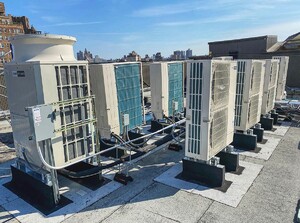 Installation of air-cooled condensers on the rooftop of a West Village co-op as part of the transition to energy-efficient heat pump technology.
Installation of air-cooled condensers on the rooftop of a West Village co-op as part of the transition to energy-efficient heat pump technology.
The shift to All-Electric Buildings is Accelerating
Enacted in 2021, New York City’s Local Law 154 is a groundbreaking measure aimed at phasing out the combustion of fossil fuels in buildings. While primarily impacting new buildings, the law also carries implications for certain existing structures. A clear understanding of the key aspects of Local Law 154 is crucial so that building owners and managers can work towards compliance and implement effective strategies to align with the law's objectives.
Local Law 154 Emission Limits and Combustion Restrictions
Under Local Law 154, all new buildings in New York City are subject to emission limits outlined in Section 24-177.1 of the Administrative Code of the City of New York. These limits restrict the combustion of any substance emitting 25 kilograms or more of carbon dioxide per million British thermal units of energy. Compliance with these emission limits is mandatory to avoid civil penalties, which range from $400 for the first violation to $4,000 for subsequent violations.
Who is Affected?
Local Law 154 primarily focuses on new buildings undergoing construction, establishing emission limits for combustion activities within these structures. Existing buildings are not directly impacted by the law unless they undergo major renovations or alterations requiring new construction document approvals.
Exemptions and Permitted Uses
While the law imposes strict emission restrictions, certain exceptions apply. For instance, combustion exceeding the emission limits may be permitted in devices like portable heaters or outdoor grills that are not connected to the building's gas supply or fuel oil piping system. However, these devices must be used intermittently and should not be employed for supplying heat or hot water to the building.
Submission Dates and Exemptions
Compliance with emission limits is mandatory for new buildings, but exceptions exist based on building size and submission dates for construction document approvals. For buildings of seven stories or more, applications submitted on or before July 1, 2027, may be exempted from immediate compliance. Similarly, buildings with fewer than seven stories can qualify for an exception if applications are submitted on or before December 31, 2023. Additionally, buildings subject to regulatory agreements for affordable housing have extended submission dates.
Heat Pump Technology
Local Law 154 places importance on exploring and evaluating heat pump technology as an energy-efficient alternative. Heat pumps transfer heat from one location to another using minimal electricity, providing both heating and cooling functionalities. They extract heat from air, ground, or water sources and distribute it indoors, reducing energy consumption and greenhouse gas emissions.
The Office of Long-Term Planning and Sustainability, in consultation with relevant agencies, will conduct a study on the feasibility, cost, and environmental impact of various heat pump technologies. This study will encompass centralized air source heat pumps, ground source heat pumps, solar thermal systems with storage tanks, and on-demand electric water heaters.
Recommendations for Building Owners, Boards, and Managers
When undertaking a major renovation or alterations, building owners and managers can take the following steps to stay in compliance with Local Law 154:
- Engage Professionals: Seek the expertise of registered design professionals who are well-versed in the law's requirements to provide guidance on compliance, emissions reduction strategies, and energy-efficient solutions such as heat pump technology. Additionally, consider having an energy audit performed to assess the current energy performance of your building and identify opportunities for improvement.
- Plan Ahead: Incorporate compliance considerations into the project planning phase. Assess how the renovation or alterations may impact emissions and identify opportunities to minimize them through efficient design and technology choices.
- Document and Maintain Records: Keep meticulous records of all compliance-related activities, including permits, approvals, and documentation provided by professionals involved in the project.
- Regular Monitoring and Inspections: Implement a system for ongoing monitoring and inspections to verify compliance with emission limits and other relevant provisions of the law. Regular checks help identify and rectify any non-compliance issues promptly.
Part of a broader effort alongside Local Law 97 of 2019, which places caps on greenhouse gas emissions from existing large buildings, Local Law 154 of 2021 brings significant changes to building operations in New York City, focusing on emissions reduction and the exploration of heat pump technology. Together, these laws represent a comprehensive approach towards achieving sustainability and reducing carbon footprints in the city. Building owners, boards, and managers should familiarize themselves with the provisions of the law and their potential implications to stay in compliance, avoid penalties, and reduce carbon emissions and environmental impact.
For further guidance on navigating the requirements of Local Law 154 and Local Law 97, and implementing effective compliance strategies, please contact RAND at 212-675-8844 or info@randpc.com.
